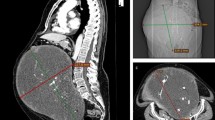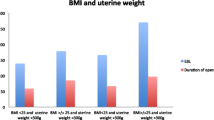Abstract
Purpose
To analyze whether a large uterine size was associated with increased rate of intraoperative and postoperative surgical complications in patients who underwent total laparoscopic hysterectomy (TLH) for myomatous uteri.
Methods
We examined prospectively data from 461 consecutive TLHs performed by a single surgeon between August 2004 and August 2014 at the Department of Obstetrics and Gynecology, Sirai Hospital, Carbonia, and at the Department of Gynecologic Oncology, Businco Hospital, Cagliari, Italy. Demographic and surgical data were stratified by uterine weight (range 90–5500 g) into four groups: <300 g; from 300 to 500 g; from 500 to 800 g; and >800 g. Outcomes examined included blood loss, operative time, intraoperative and postoperative complications, and duration of hospital stay. A linear regression analysis was performed to identify whether uterine weight was an independent predictor affecting these outcomes. In addition, BMI, previous surgery with adhesiolysis, and endometriosis were tested as a predictor of surgical complications and outcomes.
Results
No significant difference was found in intraoperative and postoperative complications, as well as hospital stay, by uterine weight. Increased uterine size was significantly associated with longer operative time and increased blood loss. Beside uterine weight, prior surgery was predictive of postoperative complications. In contrast, higher BMI was not associated with increased complication rate. Independent predictors of longer operative time included previous surgery, endometriosis, and BMI.
Conclusions
Our results showed that in experienced hands, TLH is feasible and safe also in presence of very large uteri. TLH results in a few complications and short hospital stay regardless of uterine weight.
Similar content being viewed by others
References
Merrill RM (2009) Hysterectomy surveillance in the United States, 1997 through 2005. Med Sci Monit 14:CR24–CR31
Chapron CM, Dubuisson JB, Ansquer Y (1996) Is total laparoscopic hysterectomy a safe surgical procedure? Hum Reprod 11:2422–2424
Aarts JW, Nieboer TE, Johnson N, Tavender E, Garry R, Mol BW, Kluivers KB (2015) Surgical approach to hysterectomy for benign gynaecological disease. Cochrane Database Syst Rev 8:CD003677
Bojahr B, De Wilde RL, Tchartchian G (2015) Malignancy rate of 10,731 uteri morcellated during laparoscopic supracervical hysterectomy (LASH). Arch Gynecol Obstet 292:665–672
Graebe K, Garcia-Soto A, Aziz M, Valarezo V, Heller PB, Tchabo N, Tobias DH, Salamon C, Ramieri J, Dise C, Slomovitz BM (2015) Incidental power morcellation of malignancy: a retrospective cohort study. Gynecol Oncol 136:274–277
Seracchioli R, Venturoli S, Vianello F, Govoni F, Cantarelli M, Gualerzi B, Colombo FM (2002) Total laparoscopic hysterectomy compared with abdominal hysterectomy in the presence of a large uterus. J Am Assoc Gynecol Laparosc 9:333–338
Wattiez A, Soriano D, Fiaccavento A, Canis M, Botchorishvili R, Pouly J, Mage G, Bruhat MA (2002) Total laparoscopic hysterectomy for very enlarged uteri. J Am Assoc Gynecol Laparosc 9:125–130
Uccella S, Cromi A, Bogani G, Casarin J, Formenti G, Ghezzi F (2013) Systematic implementation of laparoscopic hysterectomy independent of uterus size: clinical effect. J Minim Invasive Gynecol 20:505–516
Einarsson JI, Suzuki Y (2009) Total laparoscopic hysterectomy: 10 steps toward a successful procedure. Rev Obstet Gynecol 2:57–64
Walid MS, Heaton RL (2009) Use of bowel bags in gynecologic laparoscopy. Arch Gynecol Obstet 279:777–779
Walid MS, Heaton RL (2009) Laparoscopic extirpation of a 3-kg uterus. Arch Gynecol Obstet 279:607–608
Walid MS, Heaton RL (2010) Total laparoscopic hysterectomy for uteri over one kilogram. JSLS 14:178–182
Bonilla DJ, Mains L, Whitaker R, Crawford B, Finan M, Magnus M (2007) Uterine weight as a predictor of morbidity after a benign abdominal and total laparoscopic hysterectomy. J Reprod Med 52:490–498
Kondo W, Bourdel N, Marengo F, Botchorishvili R, Pouly JL, Jardon K, Rabischong B, Mage G, Canis M (2011) Is laparoscopic hysterectomy feasible for uteri larger than 1000 g? Eur J Obstet Gynecol Reprod Biol 158:76–81
Elessawy M, Schollmeyer T, Mettler L, Jonat W, Schem C, von Hehn U, Alkatout I (2015) The incidence of complications by hysterectomy for benign disease in correlation to an assumed preoperative score. Arch Gynecol Obstet 292:127–133
Uccella S, Cromi A, Serati M, Casarin J, Sturla D, Ghezzi F (2014) Laparoscopic hysterectomy in case of uteri weighing ≥1 kilogram: a series of 71 cases and review of the literature. J Minim Invasive Gynecol 21:460–465
Allam IS, Makled AK, Gomaa IA, El Bishry GM, Bayoumy HA, Ali DF (2015) Total laparoscopic hysterectomy, vaginal hysterectomy and total abdominal hysterectomy using electrosurgical bipolar vessel sealing technique: a randomized controlled trial. Arch Gynecol Obstet 291:1341–1345
Lafay Pillet MC, Leonard F, Chopin N, Malaret JM, Borghese B, Foulot H, Fotso A, Chapron C (2009) Incidence and risk factors of bladder injuries during laparoscopic hysterectomy indicated for benign uterine pathologies: a 14.5 years experience in a continuous series of 1501 procedures. Hum Reprod 24:842–849
Mäkinen J, Johansson J, Tomás C, Tomás E, Heinonen PK, Laatikainen T, Kauko M, Heikkinen AM, Sjöberg J (2001) Morbidity of 10 110 hysterectomies by type of approach. Hum Reprod 16:1473–1478
Vakili B, Chesson RR, Kyle BL, Shobeiri SA, Echols KT, Gist R, Zheng YT, Nolan TE (2005) The incidence of urinary tract injury during hysterectomy: a prospective analysis based on universal cystoscopy. Am J Obstet Gynecol 192:1599–1604
Brummer TH, Jalkanen J, Fraser J, Heikkinen AM, Kauko M, Mäkinen J, Seppälä T, Sjöberg J, Tomás E, Härkki P (2011) FINHYST, a prospective study of 5279 hysterectomies: complications and their risk factors. Hum Reprod 26:1741–1751
Adelman MR, Bardsley TR, Sharp HT (2014) Urinary tract injuries in laparoscopic hysterectomy: a systematic review. J Minim Invasive Gynecol 21:558–566
Fiaccavento A, Landi S, Barbieri F, Zaccoletti R, Tricolore C, Ceccaroni M, Pomini P, Bruni F, Soriano D, Stepniewska A, Selvaggi L, Zanolla L, Minelli L (2007) Total laparoscopic hysterectomy incases of very large uteri: a retrospective comparative study. J Minim Invasive Gynecol 14:559–563
Hur HC, Guido RS, Mansuria SM, Hacker MR, Sanfilippo JS, Lee TT (2007) Incidence and patient characteristics of vaginal cuff dehiscence after different modes of hysterectomies. J Minim Invasive Gynecol 14:311–317
Nick AM, Lange J, Frumovitz M, Soliman PT, Schmeler KM, Schlumbrecht MP, dos Reis R, Ramirez PT (2011) Rate of vaginal cuff separation following laparoscopic or robotic hysterectomy. Gynecol Oncol 120:47–51
Iaco PD, Ceccaroni M, Alboni C, Roset B, Sansovini M, D’Alessandro L, Pignotti E, Aloysio DD (2006) Transvaginal evisceration after hysterectomy: is vaginal cuff closure associated with a reduced risk? Eur J Obstet Gynecol Reprod Biol 125:134–138
Siedhoff MT, Yunker AC, Steege JF (2011) Decreased incidence of vaginal cuff dehiscence after laparoscopic closure with bidirectional barbed suture. J Minim Invasive Gynecol 18:218–223
Alperin M, Kivnick S, Poon KY (2012) Outpatient laparoscopic hysterectomy for large uteri. J Minim Invasive Gynecol 19:689–694
O’Hanlan KA, McCutcheon SP, McCutcheon JG (2011) Laparoscopic hysterectomy: impact of uterine size. J Minim Invasive Gynecol 18:85–91
Yavuzcan A, Cağlar M, Ustün Y, Dilbaz S, Kumru S (2014) Evaluation of the outcomes of laparoscopic hysterectomy for normal and enlarged uterus (>280 g). Arch Gynecol Obstet 289:831–837
Acknowledgments
Work supported by the “Associazione Sarda per la ricerca nell’Oncologia Ginecologica-ONLUS” with a funding from Banco di Sardegna Foundation (Grant No. 5335, 2014). The authors thank Cristian Quaggia, Tina di Simone, Martina Trudu, Federica Concas and Andreea Voicu for their technical assistance.
Author information
Authors and Affiliations
Corresponding author
Ethics declarations
Conflict of interest
The authors declare that they have no conflict of interest.
Ethical approval
All procedures performed in the study were in accordance with the ethical standards of the institutional and/or national research committee and with the 1964 Helsinki declaration and its later amendments.
Rights and permissions
About this article
Cite this article
Macciò, A., Chiappe, G., Kotsonis, P. et al. Surgical outcome and complications of total laparoscopic hysterectomy for very large myomatous uteri in relation to uterine weight: a prospective study in a continuous series of 461 procedures. Arch Gynecol Obstet 294, 525–531 (2016). https://doi.org/10.1007/s00404-016-4075-0
Received:
Accepted:
Published:
Issue Date:
DOI: https://doi.org/10.1007/s00404-016-4075-0




